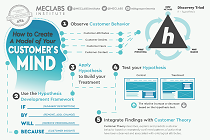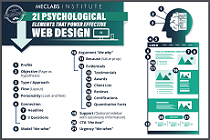
|
SUMMARY:
A platform – quite literally – is the foundation for everything else that is going on. Think of a platform at a train station. A viewing platform. Or the inaugural platform. We marketers have of course co-opted the word, but in this article we go back to its roots to explore a company that used Facebook Groups as its discovery platform, YouTube as a lead gen platform, and (because all marketing isn’t external) consolidated on an internal creative management platform to gather data to lobby internally for resources. Read on for examples from Woolworths Group, a software company, and an online education company. |

This article was originally published in the MarketingSherpa email newsletter.
The platform. A catchall term to describe the technological underpinnings of our marketing programs.
The capabilities they provide are vital to our marketing success. Here’s a perfect example. The information collected by data platforms is so vital, that in Data Pattern Analysis: Learn from a coaching session with Flint McGlaughlin the MECLABS Institute team recommends you have a backup data platform in case there are any issues with your main platform (MECLABS is the parent organization of MarketingSherpa).
So in this article, we bring you examples from your peers to spark your own thinking – two businesses that generated revenue from organic social media platforms to drive revenue and a company using an internal platform to track and execute marketing campaigns.
“A great way to generate more leads and sales is to utilize Facebook Groups to spend time with your ideal customers. There are over 600 million Facebook Groups online today,” said Roman Peysakhovich, CEO, Onedesk. If you can find groups specific to your niche, you can get in front of an audience of potential customers.
Office managers use Onedesk to book services. “Our marketing team found hundreds of Facebook Groups dedicated strictly to office managers and the decision-makers in the office who contract our services,” he said.
They began by joining the groups and using the search functions to find threads about their particular service and seeing what types of requests were discussed by office managers.
The team observed a pattern in requests – with many posts about a few common challenges. They were shocked to discover that some of the groups with over 50,000 members had all complained about the same five to ten issues repeatedly. They saw this as an excellent opportunity to adjust the platform to offer a quick solution for these issues.
“Joining Facebook groups has been a massive contributor to the growth of our sales and leads,” Peysakhovich said. They started being active in these groups just six months ago and have built relationships with members that make up 20% of total customers.
Monthly recurring revenue increased from about $2,000 per month in July 2020 to $140,000 in December 2020. Peysakhovich attributes that huge growth to the fact that offices that had been closed because of the COVID-19 pandemic began reopening mid-summer, but did note that as far as total leads contacted and quotes sent, about two-thirds came from the Facebook Groups.
“In a world where cold emails and social ads have become the norm, it can be hard to find new lead gen tactics. One approach we have discovered for uncovering new leads that has proved pretty successful is through the comments section on YouTube,” said John Ross, CEO, Test Prep Insight, an online education company with 10 employees.
Ross explained his approach – if you don’t already have a YouTube channel, create one, and start producing videos. Whatever industry you are in, there are videos you can produce to address your ideal customers’ challenges and add value to their lives. Lean into your expertise and create some helpful videos that target your customer base.
Then, in the video, call for viewers to leave a comment. Do this two or three times throughout the course of the video. Then once comments start rolling in, you can respond directly to viewers in the comment section or track them down through their profile and get their contact info as a lead.
“It is a pretty expensive and labor-intensive process with granular work to identify individual leads, but we have found it to be highly effective. In our experience, roughly 13% of these leads ultimately end up driving a sale,” Ross said.
Leanne Thompson is a creative that knows her numbers. The creative operations manager at Endeavor Drinks calculated that in 2020 her team completed 980 (internal) client requests, completing 1,429 creative projects, which collectively were reviewed 11,110 times and accrued 27,451 comments from reviewers.
Those creative projects span a wide variety tasks – from digital, video and animation to websites, print and point-of-sale displays. Her team even supported events like wine tastings and photoshoots at vineyards. Each project required, on average, 3.9 days in review and evolved through an average of 1.7 versions.
The numbers are important because they demonstrate the value the creative team is delivering to the company. That is key when lobbying for resources inside a large company like hers, which runs nine brands of alcoholic beverages as part of the Woolworths Group, a publicly-traded Australian company.
Moreover, gathering such quantitative benchmarks would have been virtually impossible the year prior. Each of the nine drink brands had their own creative team, each with a different process for managing creative work. There was no single system of record. Some teams used generic project management tools – others used email, chat and spreadsheets.
Managing 30,000 comments from reviewers sounds like a lot of work, but that was just the tail end of the challenges. Processes were prone to go sideways even at the very beginning of the creative process – with creative briefs.
“There was no place for requesters to properly submit a brief – they would email or chat the designers directly and it was often extremely difficult to decipher what was actually needed without a clear guided brief,” said Thompson, Studio & Creative Operations Manager, Endeavor Drinks.
Thompson’s mandate was to merge as many of the separate beverage company teams together into a single centralized in-house “Creative Studio.” The team would consolidate the management of creative projects into a single system – from creative brief to review and approval.
Over four months, she and her team evaluated 17 different technology platforms to support this initiative. That may sound like a lot of tools to review, but she quickly eliminated those tools that were generic.
As she puts it, “A lot of the project management tools out there are obviously not targeted towards creative workflow. As a creative team, our needs and our work environment are very unique.”
The company settled on a creative marketing and resource management platform called inMotionNow. It’s here the team collaborates and orchestrates the work of 30 creatives serving more than 250 stakeholders across the business – producing the volume of projects noted above.
It’s made the team more efficient too – there are 89 reports she produces with a click or two. For example, Leanne has tabulated that requesters spend 40% less time going back and forth (over email) with designers on creative briefs and project requests and traffic managers spend 78% less time reviewing and accepting briefs.
Less time spent on admin duties like these gives the creative team more time and space to do what they were hired to do – be creative.
The team will need this efficiency and ability to execute to feed the content beast. Endeavor Drinks is expecting a 140% increase in creative projects over the next 12 months and expects to grow its footprint in content creation substantially.
Social Media Marketing: 4 steps to identifying the ideal social media platform for your company
Social Media Platform Selection: Keep your eye on the bigger picture
Online Testing and Optimization: 4 factors to choosing a testing platform
Get Better Business Results With a Skillfully Applied Customer-first Marketing Strategy

The customer-first approach of MarketingSherpa’s agency services can help you build the most effective strategy to serve customers and improve results, and then implement it across every customer touchpoint.
Get More Info >MECLABS AI

Get headlines, value prop, competitive analysis, and more.
Use the AI for FREE (for now) >Marketer Vs Machine

Marketer Vs Machine: We need to train the marketer to train the machine.
Watch Now >Live, Interactive Event

Join Flint McGlaughlin for Design Your Offer on May 22nd at 1 pm ET. You’ll learn proven strategies that drive real business results.
Get Your Scholarship >Free Marketing Course

Become a Marketer-Philosopher: Create and optimize high-converting webpages (with this free online marketing course)
See Course >Project and Ideas Pitch Template

A free template to help you win approval for your proposed projects and campaigns
Get the Template >Six Quick CTA checklists

These CTA checklists are specifically designed for your team — something practical to hold up against your CTAs to help the time-pressed marketer quickly consider the customer psychology of your “asks” and how you can improve them.
Get the Checklists >Infographic: How to Create a Model of Your Customer’s Mind

You need a repeatable methodology focused on building your organization’s customer wisdom throughout your campaigns and websites. This infographic can get you started.
Get the Infographic >Infographic: 21 Psychological Elements that Power Effective Web Design

To build an effective page from scratch, you need to begin with the psychology of your customer. This infographic can get you started.
Get the Infographic >Receive the latest case studies and data on email, lead gen, and social media along with MarketingSherpa updates and promotions.